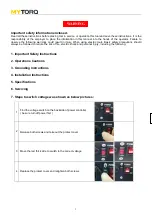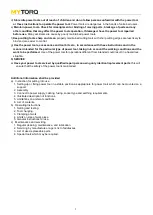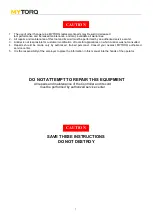
3
d)
Store idle power tools out of reach of children and do not allow persons unfamiliar with the power tool
or these instructions to operate the power tool.
Power tools are dangerous in the hands of untrained users.
e)
Maintain power tools. Check for misalignment or binding of moving parts, breakage of parts and any
other condition that may affect the power tools operation. If damaged, have the power tool repaired
before use.
Many accidents are cause by poorly maintained power tools.
f)
Keep cutting tools sharp and clean
, properly maintained cutting tools with sharp cutting edges are less likely to
bind and are easier to control.
g)
Use the power tools, accessories and tool bits etc., in accordance with these instructions and in the
manner intended for the particular type of power tool, taking into account the working conditions and the
work to be performed.
Use of the power tool for operations different from intended could result in a hazardous
situation.
5) SERVICE
a)
Have your power tool serviced by qualified repair person using only identical replacement parts
, this will
ensure that the safety of the power tool is maintained.
Additional information shall be provided
a) Instruction for putting into use
1. Setting-up or fixing power tool in a stable position as appropriate for power tools which can be mounted on a
support.
2. Assembly
3. Connect to power supply, cabling, fusing, socket type and earthing requirements.
4. Illustrated description of functions.
5. Limitations on ambient conditions.
6. List of contents.
b) Operating Instructions.
1. Setting and testing.
2. Tool changing.
3. Clamping of work.
4. Limits on size of work piece.
5. General instructions for use.
c) Maintenance and servicing.
1. Regular cleaning, maintenance, and lubrication.
2. Servicing by manufacture or agent, list of addresses.
3. List of user-replaceable parts.
4. Special tools which may be required.


























